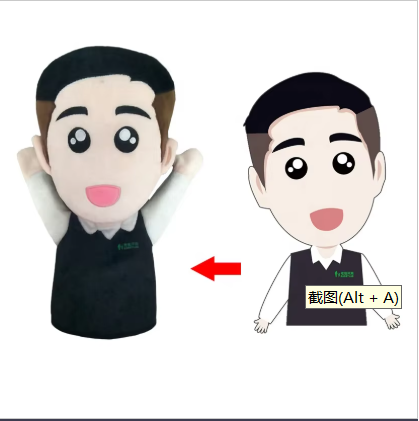Izvēle no labākajiem tēraudēm Mīkstajam rokas buram s
Plīvēna: mīkstums un ilgtspēja vienā
Flīces audums lieliski piemērots bērnu roku leļļu izgatavošanai, jo tas ir maigs, tomēr pietiekami izturīgs, lai izturētu dažādas spēļu laika situācijas. Leļļu izgatavotāji novērtē, ka flīce nesāk sabojāties un to var notīrīt, kad mazās rokas kļūst netīras. Pēc daudziem mazgāšanas cikliem, lielākajai daļai flīču saglabājas forma un struktūra, kas ir svarīgi vecākiem, jo bērni mēdz izmētāt šīs rotaļlietas. Tomēr galvenā priekšrocība ir plašs krāsu un rakstu klāsts, kas pieejams flīces materiālos. Spilgti sarkani, zili un pat dzīvnieku raksti ļauj leļļu dizaineriem izveidot tēlus, kas rosina bērnu iztēli stāstu laikā. Nesen publicēts pētījums, ko veikuši tekstilu zinātnieki, parādīja, ka kvalitatīvi flīces iztur desmitiem veļas mazgāšanas ciklu, nezaudējot izturību, kas izskaidro, kāpēc tik daudzi rotaļlietu ražotāji izvēlas šo materiālu, neskatoties uz lētākiem alternatīviem tirgū.
Minky materiāls premium tekstuurai
Minky audums ir ļoti maigs, kas lieliski piemērots, kad bērni vēlas fiziski mijiedarboties ar lellēm. Šie audumi ir pieejami dažādos jocīgos rakstos, kas pievelk mazo skatītāju uzmanību, kad tie rotaļājas. Tā kā lielākā daļa minky audumu ir izgatavota no poliestera, tie izturīgi pret nodilumu, kas ir ļoti svarīgi, jo lelles tiek lietotas ikdienā. Daudzi pedagogi ir pamanījuši, ka bērni labāk reaģē uz rotaļlietām, kuras ir patīkami just rokās, un tieši šeit minky audums ir lielisks variants. Tāpēc daudzi leļļu meistari dod priekšroku minky audumam, jo tas apvieno lietderīgumu un prieka elementu, kas palīdz uzturēt bērnu interesi rotaļas laikā.
Felt: vieglais un viegli formas maināmais materiāls
Izgatavojot lelles, reti kāds materiāls ir tikpat elastīgs kā vilnāis. Māksliniekiem patīk ar to strādāt, jo var izgriezt dažādas formas un viegli pievienot dekoratīvus elementus. Vilnāis arī labi griežas un šujas, tāpēc tas ir lielisks variants iesācējiem, kuri sāk veidot savas lelles. māja .Krāsu izvēle ir arī ļoti iespaidīga — gandrīz katra iedomājama nokrāsa, tāpēc roku darbu meistari var pielāgot savus lelles attiecīgajai tēmai, kuru viņi iedomājušies. Saskaņā ar Craft Magazine, salīdzinot ar citiem audumiem tirgū, šis materiāls arī nebremzē lēcēju. Lai ietaupītu budžetu, tomēr vēlētos radīt ko īpašu, filcs ir tieši tas saldais punkts starp lētu un radošu.
Bumbiermaizes maiņas uzelpošanai
Leļļu meistari bieži izvēlas vates maisījumus, kad viņiem ir nepieciešams kaut kas, kas ļauj gaisam iziet cauri, jo bērni spēļu laikā ātri uzsilst. Šos maisījumus padara tik labus to īpašības, ka tie sajauc vates dabiskās sastāvdaļas ar dažiem sintētiskiem piedevām, kas padara to izturīgāku. Ir arī daudz dažādu dizainu – no animācijas varoņiem līdz vienkāršiem vienkrāsas variantiem, tāpēc gan bērni, gan viņu vecāki parasti atrod kaut ko sev patīkamu. Vate jau sen ir pierādījusi savu labo kvalitāti rotaļlietu pasaulē, jo tā saglabā mīkstumu pat pēc daudzkārtējas lietošanas, tāpēc lielākā daļa mīksto rokas leļļu tiek izgatavotas tieši no šī materiāla, kad visvairāk svarīga ir elpojamība un komforts.
Būtiskie aizpildījumi struktūrai un minkstumam
Poliestera aizpildījums: alerģijas neiespaidojošs atbalsts
Lielākā daļa leļļu meistaru izvēlas poliestera šķiedras, kad viņi vēlas, lai viņu mīkstās leļļu izstrādājumiem būtu laba forma un vienlaikus būtu mīksti un patīkami taustīt. Šī viela ir ļoti viegla, tāpēc leļļu izmantošana izrāžu laikā nekļūst nogurdinoša, turklāt tā neizraisa diskomfortu bērniem, kuriem varētu būt ādas problēmas vai alerģiskas reakcijas. Viena no lielajām priekšrocībām šai materiālai ir tā izturība. Pat pēc desmitiem reižu mazgāšanas tā saglabā savu formu un neizplūst, tādējādi leļļu kalpošanas laiks var sasniegt vairākus gadus, nevis tikai dažus mēnešus. Ja paskatās uz to, kas notiek ar rotaļlietu ražošanu pašlaik, poliestera šķiedras joprojām dominē kā galvenais pildījums mīkstajām rotaļlietām tieši pateicoties šīm praktiskajām īpašībām, lai gan daži mākslinieki reizēm eksperimentē ar alternatīviem risinājumiem.
Formas ievietojumi mutes mehānismiem
Veidojot šos elastīgos mute lomu roku leļļu izgatavošanai, putas ievietošana patiešām nāk par labu. EVA putas darbojas lieliski, jo tās ir izturīgas, lai izturētu, bet ne pārāk smagas, tāpēc leļļu mākslinieki var tās viegli pārvietot, neuztraucoties par veida izkropļojumiem vai deformāciju. Šīs putu detaļas palīdz uzturēt leļļu labu izskatu pat pēc daudzām izrādēm vai bērnu rotaļām visu dienu. Leļļu izgatavotāji atklāj, ka putas ilgstoši iztur, kas ir saprotams iemesls, kāpēc daudzi izvēlas tās izmantot savos darbos. Pievienojot šīs putu sastāvdaļas, roku leļļu izjūta kļūst dzīvāka un reaģējošāka, mijiedarbojoties ar publiku, kas izceļas gan profesionālā teātra vidē, gan arī mājas izklaides laikā.
Ilgtspējīgi strukturālie komponenti louteņu funkcionalitātei
Plastmasas vai šaumas mutu plāksnes
Plastmasas un putu mute plates izvēle puppeta darbībām ir diezgan svarīga. Putu varianti ir viegli uz rokām, tos ir vieglāk pārvietot un parasti komfortablāki, strādājot vairākas stundas pēc kārtas. Plastmasas alternatīvas piedāvā ko citu – gan tās ir smagākas, tomēr daudz izturīgākas, nodrošinot stabilu pamatu precīziem mute kustībām izrādēs. Šīs divas materiālu veidi ietekmē puppeta kustības un ilgmūžību laikā. Puta dabiski liecas un līkst, taču ilgstošas lietošanas rezultātā tās beidzot parāda nodiluma pazīmes. Plastmasa ilgāk iztur, neskatoties uz to, ka sākumā tā var likties mazāk piemērota. Vairums pieredzējušu puppetu meistaru iesaka padomāt par to, kāda veida izrādēs puppets tiks izmantots, un cik intensīvām būs kustībām, pirms izvēlēties vienu materiālu pretēji citam.
Uzcilāti saujas ar stipru nienu
Augstas kvalitātes diegs padara visu atšķirību, nostiprinot tās augstās slodzes zonas lēlē, kur šuves tendēt izjukt. Aizdara diegs darbojas labi smagāku darbu veikšanai, savukārt poliesters nodrošina pieņemamu izturīgumu zemākā cienā, lai gan saderība ar dažādiem audumu veidiem arī ir svarīga. Lēlai ir vajadzīgas stipras šuves, lai izturētu pastāvīgu manipulēšanu izrāžu laikā, neizjukstot pa šuvēm patiesībā. Vairums rotaļlietu ražotāju izmanto smagās veiktspējas diegus bērnu rotaļlietām, jo drošības noteikumi to prasa, taču pat ārpus atbilstības prasībām, pastiprinātais šujamais vienkārši ir jēgpilns visam, kas tiek izmantots atkārtoti. Lēlas, kas izgatavotas ar pareizu šuvju pastiprināšanu, ilgst daudz ilgāk izpildītāju rokās, kuriem ir vajadzīgi uzticami rekvizīti izrādei pēc izrādes.
Drošības uzmanība materiāliem, kas paredzēti bērniem
Neskartības sertifikācijas standarti
Izgatavojot leļļu rotaļlietas bērniem, ir ļoti svarīgi izmantot materiālus, kas atbilst netoksiskuma standartiem. Standarti, piemēram, CPSIA, palīdz nodrošināt, lai bērnu rotaļlietās nonāktu kaitīgas ķimikālijas. Galu galā, bērnu rokas bieži visu laiku spēlēties ieliek mutē. Organizācijas, piemēram, ASTM International, veic rūpīgus testus, lai pārbaudītu, vai materiāli patiešām atbilst šiem drošības nosacījumiem. Apskatot iepriekšējās rotaļlietu atsaukšanas, kļūst skaidrs, cik svarīga ir pareiza sertifikācija. Vecāki vēlas justies droši, zinot, ka viņu bērns spēlējoties nav pakļauts bīstamām vielām. Katram, kas izgatavo leļļas jaunākai auditorijai, papildu solis, lai pārbaudītu materiālu sertifikācijas, nav vienīgi laba prakse — šodienas apstākļos tas ir gandrīz nepieciešams.
Vainagot pieslēgumus, kas var radīt slodzeņa briesmu
Mazi noņemami piederumi lellēs var radīt patiesu aizrijšanās briesmas, tāpēc ir jēga tos izvairīt, cik vien iespējams. Tā vietā, lai izvēlētos dārgas mazas rotaslietas, kas vienkārši nokrīt, var izmēģināt ko citu, piemēram, izšuvumu vai dekorus, kas stingri išūti. Šādas iespējas ļauj meistariem izpaust savu radošumu, vienlaikus saglabājot drošību. Arī laba meistarība ir svarīga, izvēloties materiālus lellēm. Pareizā izvēle samazina negadījumu risku, nevis liek lellei izskatīties garlaicīgai. ASV Patērētāju preču drošības komisijas statistika liecina, ka aizrijšanās ar rotaļlietām joprojām ir liela problēma, tādēļ rūpīgs plānojums konstrukcijas procesā patiešām ir būtisks. Stingri išūtie pavedieni un bez vaļīgām daļām radītās lelles darbojas labi un nerada problēmas.
Uzturēšanas padomi, lai saglabātu materiāla kvalitāti
Delikātas tērušanas metodes tekstilē
Lai leļļu audumi saglabātu labu izskatu, jāzina, kā tos pareizi mazgāt atkarībā no materiāla. Auksts ūdens kopā ar maigu ziepēm ir vislabākais risinājums jutīgiem materiāliem, piemēram, mākslīgai zaķādai, PV flanelei vai ļoti mīkstam kristāla audumam, kuru visi tik ļoti mīl. Šādi materiāli vispār necieš standarta veļas mazgāšanu. Gandrīz visi tekstilu nozares speciālisti stāsta, ka izžāvēt veļu dabiski, nevis lietot veļas žāvētāju, ir vienīgais veids, kā saglabāt drēbes neskartas. Samta un dabiskie šķiedru materiāli prasa īpašu uzmanību. Parasti pietiek ar vietēju tīrīšanu, tomēr reizēm, ja audumi ir ļoti netīri, jāizmanto sausā tīrīšana. Neuzskatiet par labu metodi audumus grozīt vai spiest izžūt. Arī karstums šeit ir ienaidnieks. Vienkārši pajautājiet kādam, kura lelle tika sabojāta pēc žāvēšanas ar augstu temperatūru.
Glabāšanas risinājumi, lai novērstu zaudējumus
Laba uzglabāšana ir ļoti svarīga, ja vēlamies, lai mūsu leļļu materiāli ilgtu ilgāk, nesabojājoties. Ievietojot lelles elpojošās auduma somās, tiek novērsta putekļu iekļūšana un aizsargāts pret moliem. Arī uzglabāšanas vietā kontrolēt temperatūru un mitrumu līmeni ir ļoti svarīgi, lai materiāli ilgāk saglabātu savas īpašības. Piemēram, tās greznās drēbes, kas izgatavotas no mākslīgā zaķādas vai samta, nedrīkst nonākt vietās, kur pārāk karsti vai auksti, citādi tās var sarukt vai zaudēt izturību. Veicot dažus pamata pasākumus, lai uzturētu piemērotus apstākļus ap leļļu kolekcijām, patiešām var ievērojami pagarināt to mūžu. Gandrīz visi, kas strādā ar tekstilēm, zina, ka, ja priekšmeti tiek uzglabāti labos apstākļos, tie lēnāk nodilst un ilgāk saglabā savu sākotnējo struktūru.
Bieži uzdotos jautājumus
Kas ir daži labākie audumi mīkstajam rokas buram s?
Labākie audumi makaronu rokas marionetēm ietver fleecu, minki audumu, filcu un bumbieru saiņojumus, jo tie piedāvā ilgtspēju, vizuālo pievilcību un komfortu.
Kāpēc poliestera plenam bieži tiek izmantots makaronu rokas marionetēs?
Poliestera vlāks ir viegls, neizraisot alerģijas, un pēc daudziem mazgāšanas gājieniem saglabā savu formu, kas to padara ideālu minkstajiem rokas buramtiem.
Kādas faktorus vajadzētu ņemt vērā buramta drošības standartos?
Buramta drošības standarti vajadzētu ņemt vērā materiālu nekaitīgu sertifikāciju un dizaina elementus, kas samazina deguna briesmas.
Kā var saglabāt buramtas tēraudas uzturēšanas laikā?
Buramtas tēraudas uzturēšana prasa delikātas mazgāšanas tehnikas izmantošanu, izmantojot dzimuļu ūdeni un mierīgus detergents, gaisā šķiet un piemērotu glabāšanas risinājumu.


